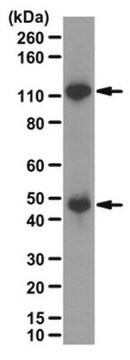05-1354
Anti-Histone H3 Antibody (Dimethyl K9, Phospho S10), clone 6HH3-2C5
ascites fluid, clone 6HH3-2C5, from mouse
Synonyme(s) :
H3K9me2S10P, Histone H3 (di methyl K9, phospho S10), H3 histone, family 3B (H3.3B)
About This Item
Produits recommandés
Source biologique
mouse
Niveau de qualité
Forme d'anticorps
ascites fluid
Type de produit anticorps
primary antibodies
Clone
6HH3-2C5, monoclonal
Espèces réactives
human
Réactivité de l'espèce (prédite par homologie)
Drosophila (based on 100% sequence homology)
Technique(s)
immunocytochemistry: suitable
western blot: suitable
Isotype
IgG1κ
Numéro d'accès GenBank
Numéro d'accès UniProt
Conditions d'expédition
wet ice
Modification post-traductionnelle de la cible
dimethylation (Lys9), phosphorylation (pSer10)
Informations sur le gène
human ... H3F3B(3021)
Description générale
Spécificité
Immunogène
Application
A 1:500 dilution of a representative lot of this antibody detected Dimethyl (Lys9)-Phospho (Ser10) Histone H3 in A431 and HeLa cells.
Epigenetics & Nuclear Function
Histones
Qualité
Western Blot Analysis:
A 1:1,000 dilution of this antibody detected Dimethyl (Lys9)-Phospho (Ser10) Histone H3 in 10 µg of untreated and Etoposide-treated HeLa acid extracts.
Description de la cible
Forme physique
Stockage et stabilité
Handling Recommendations: Upon receipt and prior to removing the cap, centrifuge the vial and gently mix the solution. Aliquot into microcentrifuge tubes and store at -20°C. Avoid repeated freeze/thaw cycles, which may damage IgG and affect product performance.
Remarque sur l'analyse
Untreated and Etoposide-treated HeLa acid extracts.
Informations légales
Clause de non-responsabilité
Vous ne trouvez pas le bon produit ?
Essayez notre Outil de sélection de produits.
Code de la classe de stockage
12 - Non Combustible Liquids
Classe de danger pour l'eau (WGK)
nwg
Point d'éclair (°F)
Not applicable
Point d'éclair (°C)
Not applicable
Certificats d'analyse (COA)
Recherchez un Certificats d'analyse (COA) en saisissant le numéro de lot du produit. Les numéros de lot figurent sur l'étiquette du produit après les mots "Lot" ou "Batch".
Déjà en possession de ce produit ?
Retrouvez la documentation relative aux produits que vous avez récemment achetés dans la Bibliothèque de documents.
Notre équipe de scientifiques dispose d'une expérience dans tous les secteurs de la recherche, notamment en sciences de la vie, science des matériaux, synthèse chimique, chromatographie, analyse et dans de nombreux autres domaines..
Contacter notre Service technique